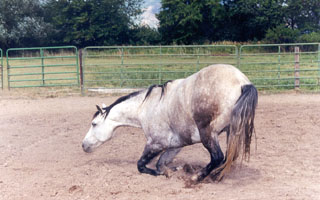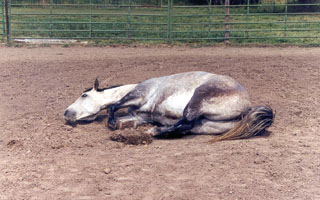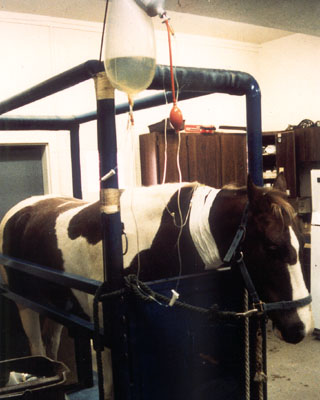
| A colicky horse will sweat, act uncomfortable, and want to roll. |
General Information:
Causes: True colic, involving the intestines or stomach, can be caused by many different things:
Risk Factors: Many times it is not known why an animal colics. Here are a few possibilities:
Clinical Signs: (One or all of these signs can be present.) The horse may act uncomfortable or uneasy and play with the feed or water bucket. The horse often sweats, rolls, paws, and even kicks at its abdomen. Curling of the lips, turning of the head towards the flank, and stretching are often seen. Some of the more severe signs include getting up and down aggressively, rolling to the point of injury, and severe lethargy. See figures 1-3.
Diagnosis: It is important to begin with an overall evaluation of the horse, reflecting on the past history and assessing the severity of the pain.
Feel the extremities to determine whether they are warm or cold.
Look at the mucous membranes of the mouth. Are they pale, with poor refill time? Are they dark red or blue in color? See page B105 for additional information.
It is a good idea to know what the normal resting heart rate of the horse is prior to this time; (normal rates in an adult range from 30-40 beats per minute). (See page A560 for normal rates or refer to page
*An animal with a rapid, weak pulse, cold extremities and poor refill time is probably in shock and should receive immediate professional attention!
- It should be considered abnormal if few to no gut sounds are heard (hypomotile), or if the gut sounds never stop (hypermotile). A normal abdomen will have some sort of gut sound in every minute.
Treatment:
- Keep the horse from consuming any more feed.
- Have a good history of past de-wormings and previous treatments, as well as when the horse last defecated.
- Allow the horse to do some light walking, particularly if the animal is rolling and is likely to injure itself.
* Be aware that excessive walking may cause the horse to over-exert and lead to exhaustion.
- Giving the horse some Banamine, IM or IV, to help with general abdominal pain.
- Giving 1/4 of the normal dose of de-wormer. This may be helpful in foals or animals that have not been de-wormed recently.
- Sedation/analgesia like Xylazine (Rompun), Torbugesic, or Ace, if needed.
- Mineral oil or other solutions into the stomach.
- IV fluids (see figure 4).

|
|

|
|

|
|

|
|
Prevention: Often it is impossible to prevent every incident of colic. However, being a conscientious and responsible owner can go a long way in preventing this problem. Good management and disease prevention practices are essential. Good nutrition, good water, and consistent de-worming are highly recommended. When a horse is thought to have colic, quick and appropriate action on the owner’s part can result in a more successful outcome.